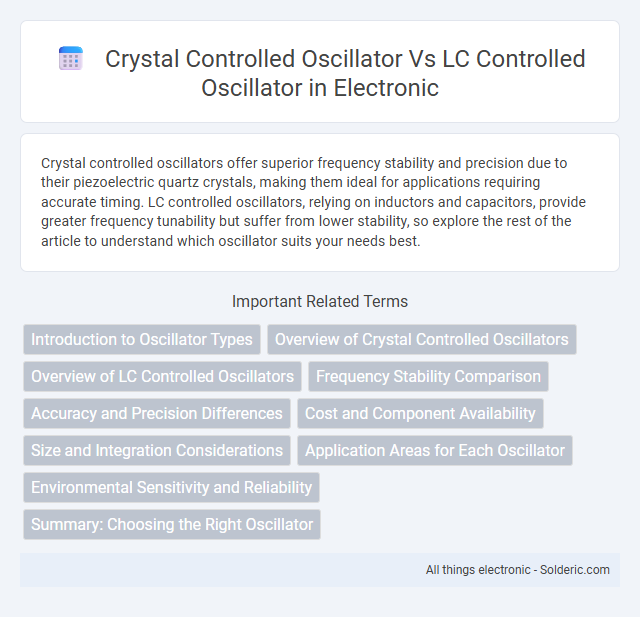Crystal controlled oscillators offer superior frequency stability and precision due to their piezoelectric quartz crystals, making them ideal for applications requiring accurate timing. LC controlled oscillators, relying on inductors and capacitors, provide greater frequency tunability but suffer from lower stability, so explore the rest of the article to understand which oscillator suits your needs best.
Comparison Table
| Feature | Crystal Controlled Oscillator | LC Controlled Oscillator |
|---|---|---|
| Frequency Stability | Very High (due to crystal's mechanical resonance) | Moderate to Low (affected by temperature and component variations) |
| Frequency Range | Limited to crystal's resonance frequencies (typically MHz range) | Wide frequency tuning possible (kHz to GHz) |
| Frequency Accuracy | Excellent (parts per million, ppm) | Lower accuracy |
| Size | Compact crystal element | Generally larger due to LC components |
| Cost | Higher cost (precision crystals) | Lower cost (inductors and capacitors) |
| Applications | Clocks, communication devices requiring stable frequency | Variable frequency oscillators, RF tuning, signal generators |
| Temperature Sensitivity | Low sensitivity | High sensitivity |
Introduction to Oscillator Types
Crystal controlled oscillators utilize piezoelectric quartz crystals to provide high frequency stability and precision, essential for applications such as telecommunications and clock generation. LC controlled oscillators employ inductors and capacitors to create variable frequency signals, offering design flexibility but generally lower frequency stability compared to crystal oscillators. The inherent resonant frequency of the quartz crystal ensures minimal drift over temperature and time, making crystal oscillators ideal for accurate timing standards.
Overview of Crystal Controlled Oscillators
Crystal controlled oscillators utilize the precise resonant frequency of a quartz crystal to maintain highly stable and accurate oscillation, essential for timing applications in communication systems and microprocessors. Compared to LC controlled oscillators, crystal oscillators offer superior frequency stability and lower phase noise due to the quartz crystal's high Q-factor and temperature compensation properties. These characteristics make crystal controlled oscillators the preferred choice for clocks, frequency references, and RF circuits requiring minimal frequency drift.
Overview of LC Controlled Oscillators
LC controlled oscillators use an inductor-capacitor circuit to determine their frequency, allowing for tunable oscillation within a specific range. These oscillators offer simplicity and variable frequency control but typically exhibit lower frequency stability and higher phase noise compared to crystal controlled oscillators. Your choice depends on the need for frequency precision versus flexibility in tuning.
Frequency Stability Comparison
Crystal controlled oscillators offer superior frequency stability compared to LC controlled oscillators due to the high Q factor of the quartz crystal, which minimizes frequency drift over time and temperature variations. LC oscillators are more susceptible to changes in temperature, component aging, and power supply fluctuations, resulting in less precise and less stable frequency output. Choosing a crystal controlled oscillator enhances your circuit's reliability where consistent frequency accuracy is critical.
Accuracy and Precision Differences
Crystal controlled oscillators provide superior accuracy and precision due to their stable quartz crystal resonators, maintaining frequency variations within a few parts per million (ppm). LC controlled oscillators exhibit lower precision, with frequency stability often affected by temperature and component tolerances, leading to variations in the order of several ppm to tens of ppm. The intrinsic resonance of crystals ensures minimal frequency drift, making crystal oscillators ideal for applications demanding highly accurate timing.
Cost and Component Availability
Crystal controlled oscillators generally have higher initial costs due to precise manufacturing processes and limited crystal suppliers but offer excellent frequency stability. LC controlled oscillators tend to be more cost-effective and utilize widely available inductors and capacitors, providing greater component availability for various designs. Your choice depends on balancing budget constraints with the need for long-term frequency accuracy.
Size and Integration Considerations
Crystal controlled oscillators typically offer a more compact footprint due to the small size of quartz crystals, facilitating easier integration into densely packed circuit boards. LC controlled oscillators often require larger inductors and capacitors, increasing overall circuit size and complicating integration in miniature or high-frequency applications. The miniaturization potential of crystal oscillators makes them ideal for portable and space-constrained electronic devices.
Application Areas for Each Oscillator
Crystal-controlled oscillators excel in high-precision applications such as communication systems, GPS devices, and frequency synthesizers where frequency stability and low phase noise are critical. LC controlled oscillators are commonly used in RF circuits, wireless transmitters, and audio frequency generation due to their tunability and simplicity despite lower long-term stability. Each oscillator type serves distinct roles whereby crystal oscillators dominate precision-required fields and LC oscillators support cost-effective, widely tunable applications.
Environmental Sensitivity and Reliability
Crystal controlled oscillators exhibit superior environmental sensitivity and reliability compared to LC controlled oscillators due to their stable frequency output regardless of temperature, humidity, or voltage variations. Your applications demanding precision timing benefit from the crystal oscillator's minimal frequency drift and long-term stability, while LC oscillators are more susceptible to frequency shifts caused by component aging and environmental changes. This makes crystal oscillators the preferred choice for environments requiring consistent and reliable oscillation performance.
Summary: Choosing the Right Oscillator
Crystal controlled oscillators offer superior frequency stability and precision due to the quartz crystal's consistent resonant frequency, making them ideal for applications requiring accurate timing such as communication systems and precision instruments. LC controlled oscillators provide flexibility in frequency tuning and are typically used where variable frequency output is needed, but they exhibit lower stability and higher phase noise compared to crystal oscillators. Selecting the right oscillator depends on balancing frequency stability requirements against tunability and application-specific constraints.
Crystal controlled oscillator vs LC controlled oscillator Infographic

 solderic.com
solderic.com